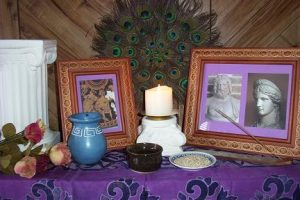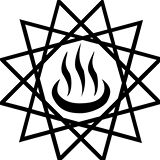by Jessi edited by Melissa
(27 Gamelion) The anniversary of the marriage (gamos) of Zeus Teleios (authority, head of the family) and Hera Teleia, giving the month its name. Not much is known about this festival except that it was celebrated with great feasting. Because the sacred marriage was commemorated this month, the month became the ideal time to marry, perhaps because of the imminent arrival of spring (Parke 104). It’s also possible, but less likely, that the month was a marriage month first, and then became the appropriate date to celebrate the union of Hera and Zeus.
Although the Theogamia probably didn’t commemorate the union of Zeus and Hera as narrated in the Iliad, the epic account does describe how such a divine union might have been imagined by the ancients:
“With that the son of Cronus caught his wife in his arms
and under them now the holy earth burst with fresh green grass,
crocus and hyacinth, clover soaked with dew, so thick and soft
it lifted their bodies off the hard, packed ground…
Folded deep in that bed they lay and round them wrapped
a marvelous cloud of gold, and glistening showers of dew
rained down around them both. And so, deep in peace,
the Father slept on Gargaron peak, conquered by Sleep
And strong assaults of Love, his wife locked in his arms.”
—Iliad, 14.413-421, translated by Robert Fagles
Ways to observe in modern times:
Give honor to current relationships or perhaps book your own wedding to occur in this month! Honor your partner. For single people, this may be a good time to think about ways that you can attain a healthy, working relationship (if you so desire) or honor the marriage of your parents. For people in relationships, think about what you have done right and wrong in the past year and what you can do in the future to be a better partner. Recite the Orphic Hymns 15 to Zeus and 16 to Hera and the Homeric Hymn 12 to Hera, or even hymns of your own creation.

Sources:
Fagles, Robert, translator, The Iliad, 1990, Penguin, New York
Parke, H.W., Festivals of the Athenians, 1977, Cornell University Press, London<
A sample ritual for Theogamia can be found here.
